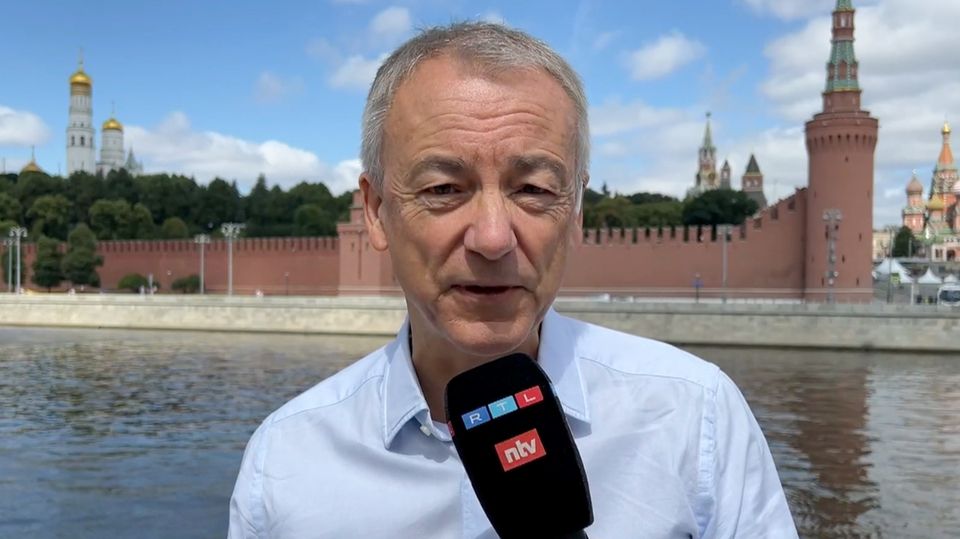Before summit
NATO countries approve plans for a possible defensive war against Russia
The NATO flag at the headquarters in Brussels
©John THYS/AFP
An attack by Russia on a NATO state? For many years, such a scenario was considered utterly unrealistic in the world’s largest defense alliance. The Russian war against Ukraine changed everything. Now there are plans again just in case.
The NATO countries have agreed on new plans to ward off possible Russian attacks on alliance territory. The documents were accepted on Monday, one day before the start of the summit meeting in Lithuania, in a written procedure, as the German Press Agency learned from several diplomats. The decision is to be confirmed again this Tuesday by the heads of state and government and then officially announced.
According to information from the German Press Agency, the defense plans, which total more than 4,000 pages, describe in detail how critical locations in the alliance area should be protected by deterrence and defended in an emergency. For this purpose, it is also defined which military capabilities are necessary. In addition to land, air and sea forces, cyber and space capabilities are also included.
“This is a direct consequence of Putin’s attack on Ukraine,” Defense Minister Boris Pistorius recently said in Brussels about the work on the new plans. It is the first time in decades that there are new plans.
Germany has an important role in the NATO plans
According to Pistorius, the plans assign Germany a double task. On the one hand, as was the case during the Cold War, due to its geographical location, it will be the logistical hub for the transfer of troops and material, he explained. On the other hand, responsibility for the eastern flank will be assumed and more deterrence and defense capability will be provided there.
Just as the old Federal Republic was in an exposed position on the eastern flank before 1989, the Baltic states are now, said Pistorius. It is important that they too can now trust that the Allies will defend their freedom and security in an emergency.
In addition to possible attacks by Russia, threats from terrorist groups are also the basis of the plans. The background is the experience with attacks by the terror network al-Qaeda on the USA on September 11, 2001, but also the pressure from countries like Turkey, which repeatedly has to deal with acts of terrorism by the banned Kurdish Workers’ Party PKK.
The fact that NATO now has to make so many changes is mainly due to the fact that the focus shifted from alliance defense to crisis management after the end of the Cold War. The main aim was to be well prepared for operations in the Balkans or the Middle East.
military alliance
From the Cold War to the Russian invasion of Ukraine: the history of NATO
The plans are to be implemented with the help of a new armed forces structure, among other things. At the NATO summit last year, Secretary General Jens Stoltenberg announced that 300,000 soldiers should be kept on standby for possible NATO deployments. So far, the NRF intervention force has been primarily intended for rapid crisis operations in NATO. The member states are currently providing around 40,000 soldiers for this.
‘Could face Article 5 situation again’
Last year, Germany had already agreed to provide a division – around 15,000 soldiers – for the new NATO troop structure. In addition, around 65 aircraft and 20 ships as well as support forces and other units with special tasks were promised.
The new defense plans envisage that the units will generally remain stationed in their respective home countries, but will be assigned to specific countries and territories – for example on NATO’s eastern flank. If necessary, the forces are transferred to their respective areas to ensure their protection there. In regions that are particularly at risk, significantly more deterrence through a permanent presence is planned. That is why Germany also wants to station around 4,000 soldiers permanently in Lithuania.
Geographically, the NATO area was divided into three regions for the planning:
- The first stretches from the US across the Atlantic to Iceland, the UK and Norway
- The second includes Europe north of the Alps with Germany, Poland, Central Eastern Europe and including the Baltic States.
- And the third stretches across the Mediterranean and the Balkans to the Black Sea regions with countries like Romania and Bulgaria.
According to information from the alliance, the planning is primarily about defending against an attack on the scale of that on Ukraine. A number of areas were also identified in which Europe now needs to do more. According to the military, more heavy forces capable of withstanding fierce combat, more anti-aircraft systems, and more long-range artillery and missile systems are needed. Investments in information and data management systems as well as in logistics are also necessary.

“We recognized that we could indeed be faced with an Article 5 situation again, in which part of NATO territory is directly attacked,” a senior NATO official told dpa. And the Ukraine war has shown that it could also be an attack on a large scale with the aim of gaining control over part of NATO territory.

